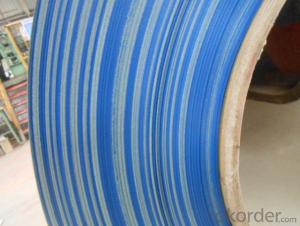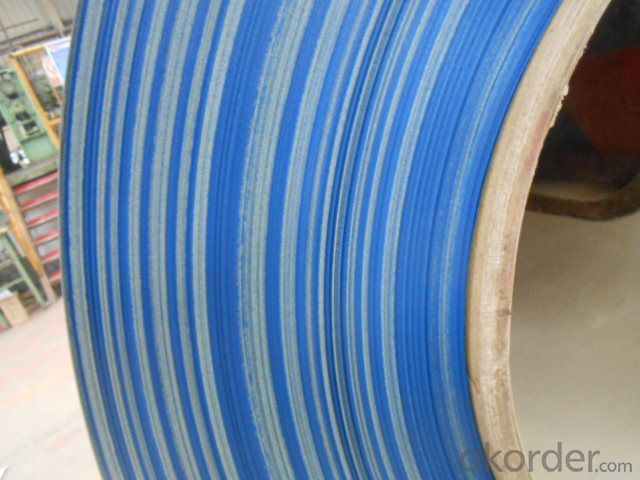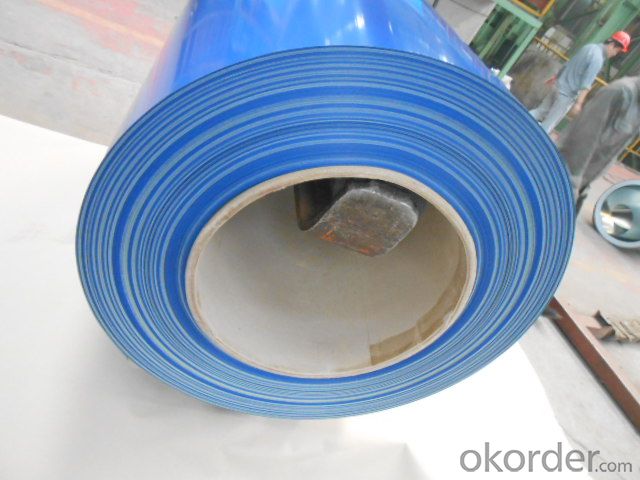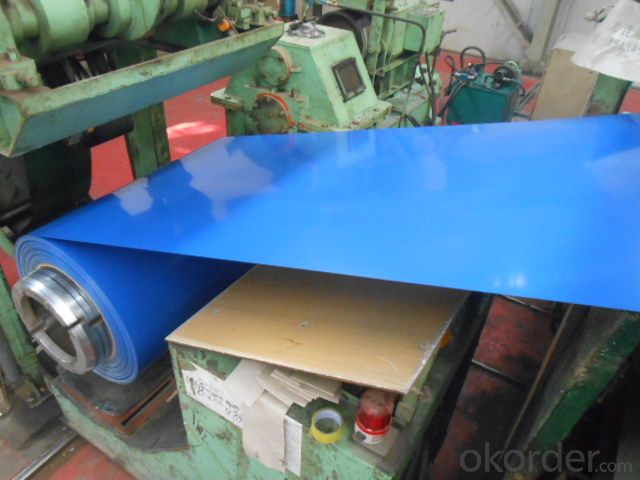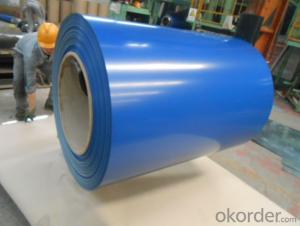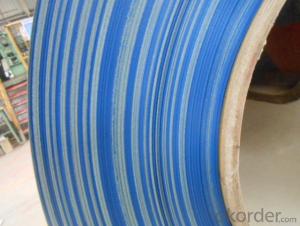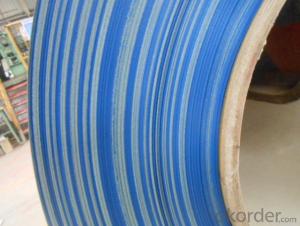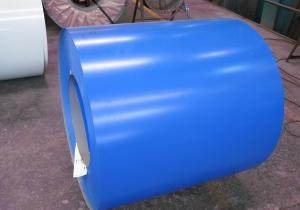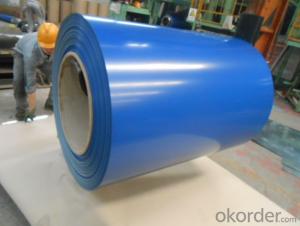PPGI,Pre-Painted Steel Coil in High Quality Blue Color Prime
- Loading Port:
- Shanghai
- Payment Terms:
- TT OR LC
- Min Order Qty:
- 200 m.t.
- Supply Capability:
- 20000 m.t./month
OKorder Service Pledge
OKorder Financial Service
You Might Also Like
1. Pre-Painted Galvanized/Aluzinc Steel Coil Description:
With GI as base material, after pretreatment (degrease and chemical treatment ) and liquid dope with several layers of color, then after firing and cooling, finally the plate steel is called pre-painted galvanized (aluzinc) steel. Pre-painted galvanized steel is good capable of decoration, molding, corrosion resistance. It generally displays superior workability, durability and weather resistance.
2.Main Features of the Pre-Painted Galvanized/Aluzinc Steel Coil:
• Excellent process capability
• Smooth and flat surface
• Workability, durability
• Excellent heat resistance performance
• High strength
• Good formability
• Good visual effect
3.Pre-Painted Galvanized/Aluzinc Steel Coil Images
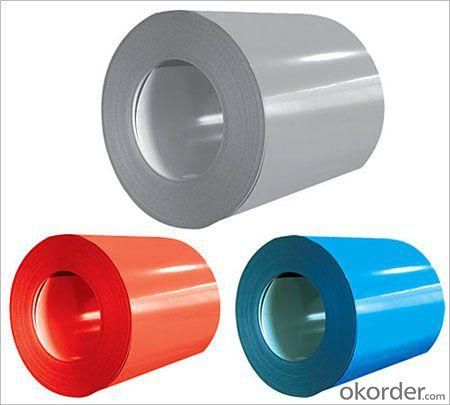
4.Pre-Painted Galvanized/Aluzinc Steel Coil Specification
Standard: AISI, ASTM, BS, DIN, GB, JIS
Grade: DX51D, DX52D
Thickness: 0.17-2.0mm
Brand Name: KMRLON
Model Number: coil
Type: Steel Coil
Technique: Cold Rolled
Surface Treatment: Coated
Application: Boiler Plate
Special Use: High-strength Steel Plate
Width: 20-1250mm
Length: customized
commoidty: pre-painted galvanized steel coil
Thickness: 0.13-4.0mm
width: 20-1250mm
zinc coating: 40-180g/m2
printing thickness: top side: 20+/-5 microns, back side: 5-7 microns
color: all RAL color
surface treatment: color coated
coil weight: 4-7 tons
coil ID: 508/610mm
packaging: standard seaworthy packing
5.FAQ of Pre-Painted Galvanized/Aluzinc Steel Coil
1. What’s the application of this product?
Roof, roof structure, surface sheet of balcony, frame of window, etc.
2. What’s the brand of the paint?
We use the best brand of all of the word—AKZO.
3. How to guarantee the quality of the products?
We have established the international advanced quality management system,every link from raw material to final product we have strict quality test;We resolutely put an end to unqualified products flowing into the market. At the same time, we will provide necessary follow-up service assurance.
4. How long can we receive the product after purchase?
Usually within thirty working days after receiving buyer’s advance payment or LC. We will arrange the factory manufacturing as soon as possible. The cargo readiness usually takes 15-25 days, but the shipment will depend on the vessel situation.
- Q: How does the thickness of a steel coil affect its applications?
- The applications of a steel coil are significantly affected by its thickness. The thickness of the coil is what determines its strength, durability, and versatility, thus making it suitable for various uses in different industries. In industries where strength is of utmost importance, such as construction, thicker steel coils are preferred. Thicker coils provide higher structural integrity and load-bearing capacity, which are essential in projects involving buildings, bridges, and infrastructure. Moreover, thicker steel coils offer better resistance against bending, warping, and other forms of deformation, making them ideal for heavy-duty applications. The durability of a steel coil is also influenced by its thickness. Thicker coils exhibit greater resistance to wear, corrosion, and damage, making them suitable for harsh environments or applications that involve constant friction or exposure to elements. For instance, thicker steel coils are commonly utilized in the manufacturing of heavy machinery, automotive parts, and mining equipment, where durability is of paramount importance. Furthermore, the thickness of a steel coil determines its versatility and adaptability. Thinner coils can be easily shaped into different forms and sizes, making them suitable for applications that require intricate designs or tight tolerances. Industries such as automotive, aerospace, and consumer electronics often rely on thinner steel coils due to their lightweight and flexible nature. On the other hand, the weight and reduced flexibility of thicker steel coils may limit their range of applications. They are better suited for applications that prioritize strength and durability over versatility. These applications include structural components, large-scale machinery, and industrial equipment. To summarize, the thickness of a steel coil plays a pivotal role in determining its applications. Thicker coils offer increased strength, durability, and resistance, making them ideal for heavy-duty applications in the construction and manufacturing industries. Conversely, thinner coils provide versatility and adaptability, making them suitable for applications that require intricate designs or lightweight properties.
- Q: What is the standard width of steel coils?
- The standard width of steel coils can vary depending on the specific industry and application. However, in general, the standard width for steel coils ranges between 36 inches to 72 inches. The specific width will depend on factors such as the type of steel being used, the intended use of the coils, and the equipment used for processing and handling the coils. It is important to consult industry standards and specifications to determine the appropriate width for a particular steel coil application.
- Q: i have a guitar with three nylon three steel strings. Am i able to replace the nylons with steel strings?
- Be careful - if the guitar is strictly a classical guitar, then it is made to handle nylon strings only. If you put steel strings on a classical nylon-string guitar, you can bend the neck pretty bad due to the increased tension of the steel strings. Research your particular guitar in question and see if it is in fact a nylon-only classical guitar or not.
- Q: How are steel coils used in the production of roofing and siding?
- Steel coils are an essential component in the production of roofing and siding materials. These coils, made from high-quality steel, undergo various processes to transform them into the final products used for roofing and siding purposes. Firstly, the steel coils are uncoiled and flattened to obtain a flat sheet of steel. This sheet is then cleaned to remove any impurities or contaminants. The cleaning process involves treating the surface of the steel with chemicals and rinsing it thoroughly to ensure a clean and smooth surface. Next, the steel sheet is coated with a protective layer to enhance its durability and resistance to corrosion. This coating can be done through various methods such as hot-dip galvanizing, electro-galvanizing, or applying a layer of metallic or organic coating. The specific coating method depends on the desired properties and aesthetic requirements of the roofing or siding material. After the coating process, the steel sheet is formed into the desired shape and profile. For roofing applications, the steel sheet is typically corrugated or formed into interlocking panels. This allows for easy installation and ensures a secure and weatherproof roofing system. Similarly, for siding applications, the steel sheet can be formed into different profiles such as horizontal or vertical panels, shingles, or shakes. Once the steel sheet is formed, it may undergo additional treatments to enhance its performance. This can include applying a protective layer of paint or other finishes to improve its appearance and resistance to fading, chipping, or scratching. The steel coils can also be embossed or stamped with patterns or textures to provide aesthetic appeal. Overall, steel coils play a crucial role in the production of roofing and siding materials. They provide strength, durability, and weather resistance, making them an ideal choice for protecting buildings from the elements. Additionally, steel coils offer versatility in terms of shape, profile, and finish, allowing for a wide range of design options for roofing and siding applications.
- Q: How are steel coils used in the production of automotive exhaust systems?
- Steel coils are typically used in the production of automotive exhaust systems as they provide the necessary material for manufacturing exhaust pipes and components. The coils are often processed and shaped into the desired forms, such as tubes or mufflers, and then welded or fastened together to create the exhaust system. Steel coils are favored due to their durability, heat resistance, and ability to withstand the harsh conditions of exhaust gases, ensuring the longevity and efficiency of the automotive exhaust system.
- Q: How are steel coils used in the production of metal signs?
- Steel coils are used in the production of metal signs as they are processed and shaped into flat sheets that serve as the base material for the signs. These coils are unrolled and flattened, then cut and formed into the desired shape before being painted or coated for aesthetics and protection.
- Q: What are the common methods of inspecting steel coils for defects?
- There are several common methods used for inspecting steel coils for defects. These methods include visual inspection, ultrasonic testing, magnetic particle inspection, and eddy current testing. Visual inspection is the most basic method and involves physically examining the surface of the steel coil for any visible defects such as cracks, dents, or surface irregularities. This method is usually the first step in the inspection process and can quickly identify any obvious defects. Ultrasonic testing is a more advanced method that uses high-frequency sound waves to detect defects within the steel coil. A probe is used to transmit ultrasonic waves into the coil, and any internal flaws or defects will reflect the sound waves back to the probe. This method is effective for detecting defects such as voids, cracks, or inclusions within the material. Magnetic particle inspection is another commonly used method for inspecting steel coils. This technique involves magnetizing the coil and then applying iron particles to the surface. Any defects or cracks will cause a disturbance in the magnetic field, attracting the iron particles and making them visible. This method is particularly effective for detecting surface cracks or defects. Eddy current testing is a non-destructive method that uses electromagnetic induction to detect defects in the steel coil. A probe is used to generate an alternating magnetic field, and any changes in the electrical conductivity or magnetic permeability of the material due to defects will produce eddy currents. These eddy currents can be measured and analyzed to identify defects such as cracks, voids, or changes in material properties. Overall, these common methods of inspecting steel coils for defects provide various levels of accuracy and sensitivity, allowing for thorough inspections to ensure the quality and integrity of the steel coils. The choice of method depends on factors such as the type and size of defects to be detected, the required level of inspection accuracy, and the cost and time constraints of the inspection process.
- Q: How are steel coils used in the production of metal facades?
- The production of metal facades relies on steel coils as a vital element. These coils, typically crafted from high-quality steel, serve as the raw material for manufacturing different components of metal facades, including panels, cladding, and roofing sheets. During the production process, the steel coils go through a series of procedures. Initially, the coils are uncoiled and flattened to achieve a smooth and uniformly thick surface, ensuring the desired texture for the metal facades. Subsequently, the flattened coils are cut into specific lengths and widths, tailored to meet the design requirements of the facades. After the cutting process, the steel sheets undergo various surface treatment techniques, such as cleaning, pickling, and coating. These treatments are crucial in enhancing the durability and corrosion resistance of the metal facades. The coatings are applied using different methods, such as galvanization, powder coating, or painting, depending on the desired finish and level of protection needed. Once the surface treatment is completed, the steel sheets are shaped and formed into the desired profiles for the metal facades. This can involve processes like roll forming, bending, or stamping, depending on the complexity of the design. These shaping processes give the metal facades their distinct appearance and structural integrity. Finally, the formed steel sheets are assembled and installed onto the building structure to create the metal facade. The installation techniques employed include welding, riveting, or adhesive bonding, depending on the specific project requirements. Thus, the steel coils play a critical role in providing the necessary raw material for the production of metal facades. These facades not only enhance the aesthetic appeal of buildings but also provide protection and durability against harsh weather conditions. To summarize, steel coils are indispensable in the production of metal facades as they serve as the raw material for various components. They undergo surface treatments to enhance durability, are shaped into desired profiles, and finally, installed to create the metal facade.
- Q: Can steel coils be coated with barcodes?
- Yes, steel coils can be coated with barcodes. The barcode can be applied to the surface of the steel coil using various methods such as printing, engraving, or even attaching a barcode label. This allows for easy identification and tracking of the steel coils throughout the supply chain.
- Q: okay i got some questions of the steel plow.1st - who inveneted it? where and when?2nd - how did it work? what is it used for? what is it made of? how is it produced?okay guys thank you very much. remember best answer gets best answer 10 points!
- You want ot read up on American John Deere; he madethe first plow capable of cutting the virgin sod of the great planes.
Send your message to us
PPGI,Pre-Painted Steel Coil in High Quality Blue Color Prime
- Loading Port:
- Shanghai
- Payment Terms:
- TT OR LC
- Min Order Qty:
- 200 m.t.
- Supply Capability:
- 20000 m.t./month
OKorder Service Pledge
OKorder Financial Service
Similar products
Hot products
Hot Searches
Related keywords
